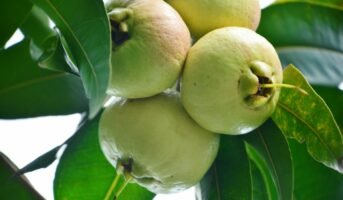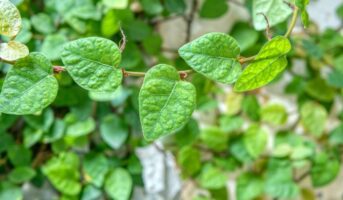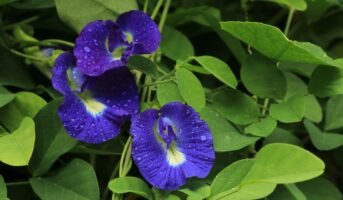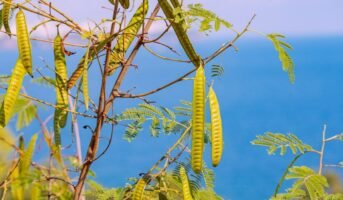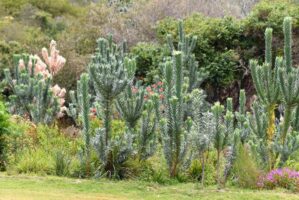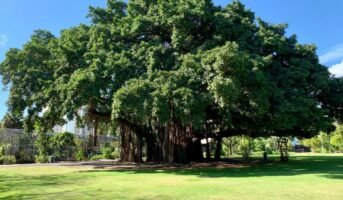Larkspur, or Delphinium, is a traditional plant for cottage gardens that makes excellent cut flowers. This plant lends elegance to any landscape and looks great in masses or blended with other annuals and perennials. It has airy stalks of blue blooms. Larkspur is a simple plant to grow from seed and will cheerfully replant itself within the garden every year. It is a real annual.

Source: Pinterest
Larkspur: Quick facts
| Botanical name | Delphinium |
| Common name | Larkspur |
| Type | Annual |
| Flower | Yes |
| Varieties available | About 365 species |
| Also known as | Lark’s heel, Lark’s claw and knight’s spur |
| Height | one to three feet |
| Width | six to 18 inches |
| Season | Summer through Fall |
| Sun exposure | Needs to be planted in full sun for the best bloom |
| Ideal temperature | Requires vernalisation, a period of cool temperatures, to start the flowering process. |
| Soil type | Needs rich, healthy soil, full sun to light shade, and great drainage |
| Soil ph | 6.0 to 7.0 |
| Basic requirements | Staking, sporadic watering during drought periods, fertilisation every month, full sun with slightly moist soil |
| Ideal location for placement | A south-facing window should be no closer than one foot away to enhance growth potential |
| Maintenance | Low |
What is the meaning of the Larkspur flower?
Larkspur is the common name for Delphinium, a class of around 300 species of annual and perennial flowering plants in the Ranunculaceae family. Larkspur has a cultural significance and denotes beautiful spirit, swiftness and positivity. As the flower grows in summer, it is also associated with youth and light-heartedness.
Larkspur: Physical description
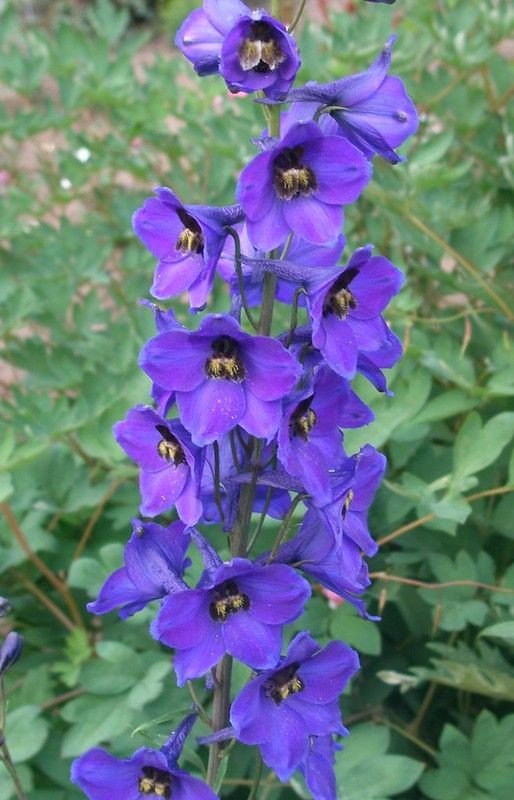
Source: Pinterest
It is simple to understand why Larkspur is planted every year because of the stunning tones of blue that the blooms range from sky to navy. In the world of flowers, blue is a difficult colour to find, yet Larkspur has an abundance of it.
These flowers come in single and double forms. Some cultivars have many petals, giving the appearance of a pom-pom. By removing old blossoms, plants will continue to bloom longer.
Larkspur flowers: Types
Sublime Larkspur
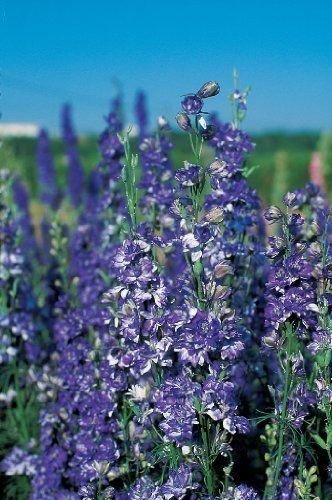
Source: Pinterest
Consolida ‘Sublime’ mix has four-foot stems covered in flower-packed spikes in a range of hues.
Cloudy skies Larkspur

Source: Pinterest
Consolida ‘Cloudy Skies’ mix has blooms on three-foot-tall plants that are various colours of silver, purple, white, and blue.
Imperial Larkspur
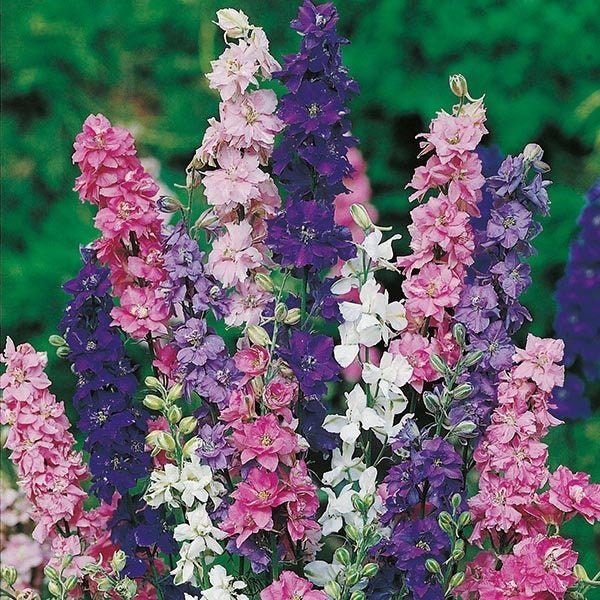
Source: Pinterest
On sturdy four-foot stems, Consolida ‘Imperial Strain’ bears magnificent spikes in hues of white, pink, blue, rose, or purple.
Larkspur: How to grow the plant?
Larkspur annual flowers are frequently cultivated from seeds. They can be transplanted, but doing so requires great care and consideration. Due to their long taproots, Larkspur plants are said to grow best from seeds. Transplanting them can be difficult because moving them around quickly affects their roots.
Before Larkspur seeds may sprout, they require a cold time. Three different methods exist for doing this:
- Prior to sowing the seeds.
- Once the seeds have been put in the containers.
- Once the seeds have been planted in the flower bed.
Before planting, you can chill the Larkspur seeds in the refrigerator. Actually, this approach is the most trustworthy one.
Before being planted, these seeds have to be safeguarded for two weeks. The seeds can be placed in a ziplock bag along with some damp perlite. The perlite will provide the seeds with moisture.
Additionally, Larkspur seeds can be sown in portable containers or planters. As they expand to fit inside your containers, be cautious of their weight and height.
You can put the seeds in damp soil and let them cool for two weeks if you have a cold room or cellar with temperatures between 40 and 50 degrees Fahrenheit. Temperatures higher than 65 degrees Fahrenheit will prevent the seeds from germinating.
The first frost date in your location must be taken into consideration while sowing Larkspur seeds. The seeds must be sown far enough in advance to allow the root system to form and support the plants through winter.
In two to three weeks, your Larkspur seeds will begin to sprout. In warm climes, plant the seeds in the yard in the early spring or late fall. To encourage the growth of roots, moisten the seeds well, but avoid letting them stand under the water.
Whenever the seedlings have developed leaves, you can formally transplant the flowers into permanent pots or your garden.
Larkspur: How to care for/maintain the plant?
They may grow in a variety of soil types, but light, well-draining soil produces the greatest results. You can alter the heavy soils in your area with composting or manure.
Larkspur plants thrive in direct sunlight as long as the ground is just damp enough. They require less moisture, although hot, dry weather inhibits their ability to bloom.
In the summer, water your plant if the weekly rainfall is less than an inch.
Add a two inches layer of mulch and a thin coating of compost in the early spring to help retain moisture. Additionally, it will prevent weeds from sprouting up in Larkspur flower beds.
Larkspur can be planted alongside other native and cottage flowers if you want to combine and contrast a few blooms in your garden. The height of these perennials can reach three feet in just one growing season. The delicate stems might need to be staked, particularly in windy conditions. They self-sow easily. Depending on your perspective, this may be a problem or a solution.
On the one hand, they might establish themselves in your garden and become invasive. However, you may only have to plant them once because they will grow every year.
Remove the spent branches and pick up any undesirable recruits if they do start to become invasive.
Because of this, wild Larkspur is occasionally thought of as an annoyance. Because the plants are toxic and potentially lethal, they should be avoided in fields where cattle forage.
The consumption of Larkspur may cause fatal losses to ranchers in some places of up to 15%.
Larkspur: What are the uses of the plant?
Medicinal use
Larkspur was once used internally to cure a variety of ailments, but nowadays, it is only seldom employed in folk medicine because it only has one reliable effect: a strong purgative. But when applied externally to kill skin parasites, it has value. See the toxicity comments above for further information on how to utilise the plant safely. The seed has vasodilator, hypnotic, mild diuretic, anthelmintic, and purgative properties.
It has been administered internally to treat dropsy and spasmodic asthma. The entire plant or the blooms have a modest diuretic and hypotensive effect. The leaf’s expressed juice has been recommended as a successful treatment for bleeding piles. When youngsters are the target of aggressive purging, a conserve made from the blossoms has been recommended as a good treatment. Additionally, colic has been treated with flower juice.
Other uses
- To kill parasites and lumens in the scalp and pubic hair, apply a potent tincture made from the fresh seed to the skin. Additionally, it works well with aphids and thrips. The extracted juice of petals combined with some alum yields a nice blue ink. Another source claims that the leaves are used in its production. When combined with alum, it turns green and is also employed as a dye.
- Larkspur blooms are regal plants that can give your landscape more architectural height. They are frequently used as a backdrop by landscaping professionals for other, more casual-looking annuals. Smaller kinds make great border plants, and they fit snugly around garden fences.
- Larkspurs are ideal for both dried and fresh floral arrangements. Fans of dried arrangements have something to look forward to because dried-cut flowers maintain their full colour.
- Since all components of the Larkspur plant are poisonous, they can assist you with pest management. But even while this might deter pests, you should also take safety measures if your garden is accessible to kids, animals, or cattle.
What to plant with Larkspur flowers?
Larkspur can be planted alongside other native and cottage flowers if you want to combine and contrast a few blooms in your garden. Some excellent plants you can consider growing along with Larkspur are sunflower, roses, hollyhock, joe pye weed, foxglove, and cosmos. You can also grow tall ornamental grasses and vegetable garden.
FAQs
Is Larkspur toxic?
All portions of the many species of Larkspur are deadly, but the seeds and new growth have the highest levels of toxins.
How much sun and soil is needed for Larkspur?
Larkspur needs full sun with slightly moist soil.
How is the frost tolerance of Larkspur?
Good. In areas with moderate winters, plants germinate in the fall and endure until spring.
What are some of the companions for Larkspur?
Some of the companion plants for Larkspur are Snapdragon, Cosmos, and Marguerite Daisy.
Housing News Desk is the news desk of leading online real estate portal, Housing.com. Housing News Desk focuses on a variety of topics such as real estate laws, taxes, current news, property trends, home loans, rentals, décor, green homes, home improvement, etc. The main objective of the news desk, is to cover the real estate sector from the perspective of providing information that is useful to the end-user.
Facebook: https://www.facebook.com/housing.com/
Twitter: https://twitter.com/Housing
Email: editor@housing.com

